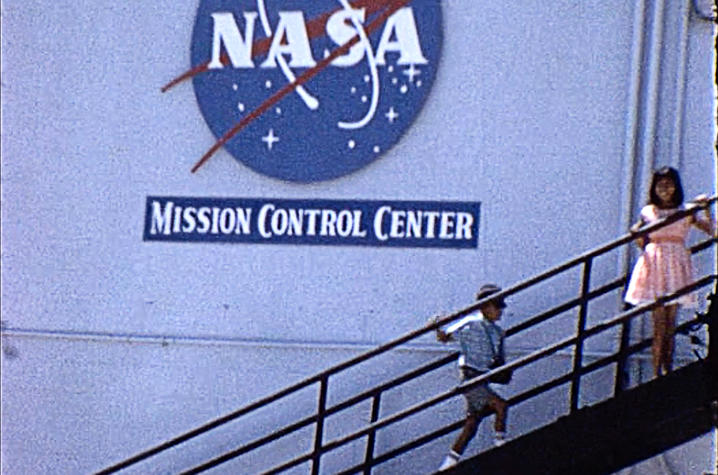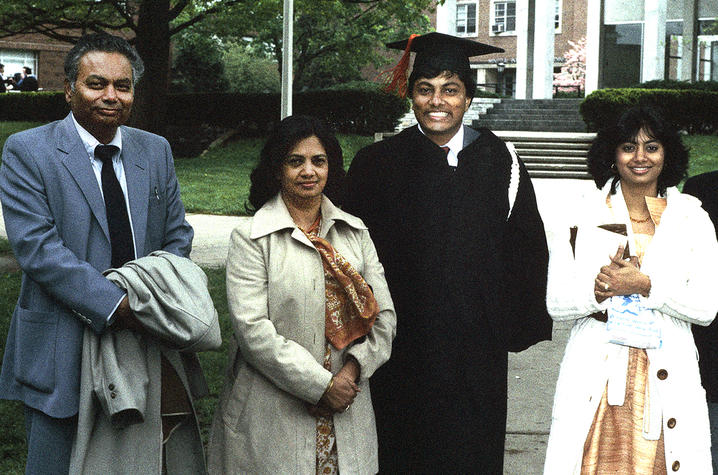UK grad ‘soars back’ after 40 years, becoming 1st to earn Ph.D. in aerospace engineering
LEXINGTON, Ky. (April 30, 2024) — From the earliest days of childhood, there are those who seem to possess an unwavering clarity about their future.
Whether it's the child who dreams of exploring the cosmos or the budding artist who finds solace in strokes of color, there's a profound sense of direction.
It’s as if the essence of who they are, their passions, and their talents, are woven into the very fabric of their being.
At just 7 years old, Sujit Sinha’s aspirations were bold — and specific. “My late mother always told me that I said, ‘I’m going to work in mission control at NASA one day.’”
Despite growing up in the small town of Morehead, Kentucky, for Sinha, working in aeronautics didn’t seem out of reach.
That spark of passion was further ignited during a family trip to the Sunshine State.
“It was the summer of 1968. And of course, a must-stop was a visit to the Kennedy Space Center during the heyday of the Apollo program,” he said. “We got to tour the historic mission control building, and that was all I needed to establish my ultimate career aspiration.”
From that moment on, Sinha could often be found spending his free time building model planes and rockets. “All the way through high school, I built rockets — striving to construct ones that flew higher and higher.”
Sinha's desire to become a mechanical engineer was fueled by his unwavering determination. Yet, he recognized the importance of furthering his education, especially if he was going to land his NASA dream job.
That’s when, in August of 1979, Sinha’s journey as a Wildcat began.
“As with many students, the first two years were quite an adjustment. Since this was long before first-year engineering courses and living learning programs, it was difficult to meet other students in my major,” he continued. “As time went on, the courses were a struggle. Then, sophomore year was one of those ‘look into the abyss’ moments, where you feel like you are just about to go into freefall.”
With family support, Sinha completed those two years. And in his junior year, he found a second family at UK.
“I met many other students in mechanical engineering, and we formed a study and social group,” Sinha said. “Now, I always advise prospective students to join a study group.”
He continued to excel socially and academically, and in 1983, Sinha proudly crossed the Commencement stage with a bachelor’s degree in mechanical engineering.
Not unlike many recent graduates, Sinha was unclear about the path forward. He was both eager to begin his career and to continue his education.
“The education I received at UK provided me with the knowledge to take my career wherever I wanted,” Sinha said. “I stress this fact with prospective UK students. But of course, you must also be relentless in the pursuit of your goals — and have just a bit of luck.”
****
As luck would have it, NASA came calling.
“I received a job offer from the Marshall Space Flight Center after only having a brief discussion with a NASA recruiter on campus,” Sinha recalled. “But I learned the role was exactly the dream job planted in my mind back in 1968. It would put me in the Launch Control Center, interacting with the mission control team in Houston.”
Those in mission control are often the underappreciated champions behind every successful space mission — navigating the intricate nuances of space travel with unparalleled precision.
At just 21 years old, Sinha found himself striving to anticipate challenges before they would arise and devising split-second contingency plans.
“During a launch, I managed the Main Propulsion System (MPS) console, with responsibility of fueling the large, brown shuttle external tank with liquid hydrogen and liquid oxygen," he explained. "Between launches, I designed the ascent flight trajectory for each space shuttle mission. Essentially, you need to get the shuttle into orbit without breaking the wings off of the orbiter, while keeping the aero-heating on the external tank (ET) within safety limits. You may recall, the reentry failure of the Shuttle Columbia was due to a piece of the ET coming off and hitting the wing of the orbiter during ascent. I also performed post-flight trajectory reconstruction after each shuttle mission.”
During that time, NASA would pay for Sinha to get a master’s degree in mechanical engineering. While completing evening courses at the University of Alabama in Huntsville, he also continued to excel in his career — holding many positions and filling many roles at NASA throughout the '80s.
A turning point came on Jan. 28, 1986 — the day of the Space Shuttle Challenger tragedy.
“Everything changed,” Sinha said.
The challenger broke apart 73 seconds into its flight, killing all seven crew members aboard. The spacecraft disintegrated 46,000 feet above the Atlantic Ocean, off the coast of Cape Canaveral and was the first fatal accident involving an American spacecraft while in flight.
“As a result, I served on the Presidential Commission’s Challenger Accident Analysis Team. As an engineer, I helped to identify and explain the technical failure that occurred, but what I did not readily comprehend was the managerial thinking that contributed to the failure,” Sinha said. “Following the accident, I decided I needed to better understand how and why business and management decision-making differs from engineering and technical decision-making.”
After six years at NASA, Sinha left to pursue an MBA from the Wharton School of Business, at the University of Pennsylvania, which ultimately led to new ventures.
“I served as a civilian consultant to the Department of Defense at the Pentagon for a couple of years,” he said. “I was mentored by a retired three-star general. He established many of the management principles for leading large organizations that I now call my own.”
Despite aspirations to continue his education, life’s demands and opportunities continued to lead Sinha down a different path — applying his mechanical engineering expertise in practical settings.
“In NASA terminology, the pursuit of a Ph.D. went into an ‘unplanned 32-year hold.’”
When asked about his career highlights, Sinha describes his time spent as a management consultant, which involved working with various high-tech and aerospace CEOs and senior executives.
“A few examples include: determining if a commercial helicopter manufacturer should introduce a new product to the market; assessing if a major aerospace firm should purchase a corporate jet maker; deciding how a U.S. commercial launch manufacturer should partner with a Russian launch provider; etc.”
Sinha also led information technology strategy, architecture and innovation at Motorola, which invented cell phones. “Leading IT innovation was exciting, as I was able to introduce many new collaboration and mobile technologies globally,” he said.
Sinha held numerous roles over the course of his illustrious career, applying his expertise in diverse capacities.
And before he knew it, years had gone by since he was an apprehensive graduate — 40 years, to be exact.
Still, Sinha considered himself a lifelong learner. So, he “retired,” began to focus more on work-life balance and contemplated his next move.
“I always had a desire to teach. So, I was definitely planning on continuing my education and earning my Ph.D.,” he said. “My parents always stressed the importance of education as a core family value. I figured that a Ph.D. was the highest degree that could be obtained in engineering, and therefore, I should certainly aim to seek this level of education.”
****
In 2021, the Stanley and Karen Pigman College of Engineering launched undergraduate and graduate degree programs in aerospace engineering.
Aerospace plays a significant role in Kentucky’s economy. In fact, aerospace exports are the top export in the state and number three in the United States — behind only California and Washington. According to the Kentucky Cabinet for Economic Development, Kentucky exported more than $14.6 billion in aerospace products in 2019.
Additionally, the Commonwealth is home to 79 aerospace-related facilities, which employ more than 19,000 people, including Belcan Corp., General Dynamics, General Electric, Lockheed Martin, Raytheon and Sikorsky Aircraft Corp.
Housed in the Department of Mechanical and Aerospace Engineering, the degree pathways foster research and innovation by enhancing collaborations between UK and the local aerospace industry.
“As a member of the engineering alumni board, over time, I learned about all of the great aerospace research going on at UK,” Sinha said. “And I began to think, once again, about finishing my Ph.D.”
So, after four decades, Sinha made the bold decision to return to UK and pursue his long-deferred dream.
Despite his commitment, being a student again wasn’t without challenges.
“You have to remember, during my undergrad I didn’t even have the internet,” Sinha exclaimed. “But the biggest challenge was re-learning all the calculus. When I would study with the “kids,” they would fly through the math associated with solving problems, so I would have to stop them and have them walk me through it. I certainly would have never completed my degree without the support of my fellow, much younger, and clearly smarter, students.”
This time around, Sinha also had the support of his two sons who attended college at the same time and graduated within a year of each other.
“There is an old tenet at the Pentagon that you should not ask the troops to do something that you are not willing to do — a leadership by example approach,” he said. “This principle is another reason I went back to finish my Ph.D., since I wanted to show my boys that I was willing to challenge myself to study along with them.”
Lastly, Sinha contributes his academic success to his mentors. “I actually had four advisors (Sean Bailey, Jesse Hoagg, Alexandre Martin and Suzanne Smith) for my Ph.D.,” he said. “The support from the faculty and college administration was invaluable to completing my degree.”
****
From the earliest days of childhood, Sinha seemed to possess an unwavering clarity about his future.
As for his definition of success, however, he now believes that comes in many forms.
Yes, Sinha’s latest accolade could help advance his future career aspirations. But he says it was never about salary or status.
Instead, his degree represents something more intangible.
“When I started at UK almost 45 years ago, I could not have imagined in my mind — nor even in any theoretical parallel universe — that I would be getting an aerospace Ph.D. from here,” Sinha said. “Much less to be the first recipient of the degree with an aerospace major. When you get older, you start to think about legacy, and this is a legacy that will endure.”
The May 2024 Commencement Ceremonies will be held on Friday and Saturday, May 3 and 4, at Rupp Arena at Central Bank Center. More information can be found here.
As the state’s flagship, land-grant institution, the University of Kentucky exists to advance the Commonwealth. We do that by preparing the next generation of leaders — placing students at the heart of everything we do — and transforming the lives of Kentuckians through education, research and creative work, service and health care. We pride ourselves on being a catalyst for breakthroughs and a force for healing, a place where ingenuity unfolds. It's all made possible by our people — visionaries, disruptors and pioneers — who make up 200 academic programs, a $476.5 million research and development enterprise and a world-class medical center, all on one campus.







